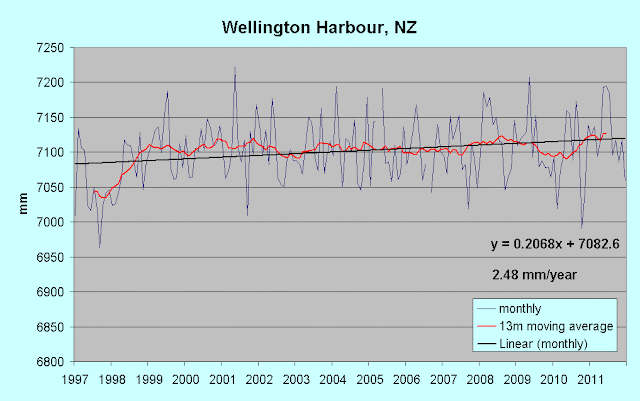Two reports released today show Wellington has the highest rate of sea-level rise in New Zealand and highlight areas in the region that are vulnerable to coastal flooding over the next 100 years.
The reports, commissioned by the Greater Wellington Regional Council (GW), look at sea-level rise and coastal flooding from storm events in the Wellington region including current trends and future scenarios based on those trends. Wave heights, wind strength, storm-tide levels, sea-level variability and large-scale storm events are all assessed.
Findings from the studies and the implications they are likely to have on the Wellington region’s coasts, communities and local authorities were presented today.... and another
Parts of coastal Wellington could be drowned if doomsday climate change predictions from a new study pan out over the next 100 years.
Two reports issued yesterday by Greater Wellington regional council show Wellington's sea level is the fastest rising in New Zealand - made worse by seismic rumblings causing the city to sink 1.7mm a year since 2000.One slight problem with all of this - sea level at Wellington has barely risen at all since 1999.
Amazingly, the NIWA report Sea-level variability and trends: Wellington Region (helpfully linked from the Scoop Business report, hats off to them) actually shows just that, though the text completely ignores the fact.
The report states on page 37:
Regional subsidence, from slow-slip events, has increased the relative sea-level trend in the Wellington area since ~1997. This trend varies across the Wellington region,Reality check - here's the plot from 1997
Does a change from 2.44 mm/year for the entire record to 2.48 mm/year for 1997 onwards constitute an "increased sea-level trend"? I leave you to judge whether it is even worth mentioning. Moving the start year forward to 1999 reveals the tiny trend I highlighted above.
Plotting the change in annual rate from 1944 to 1980 and subsequent years to 2011 confirms it.
The rate has stabilised at almost exactly 2.5 mm/year (slightly different from that shown on the first chart above as it's calculated from annual averages, not monthly data). There is a change in the rate from 1997, but it's progressively reduced to a flat trend as the 1999-onwards "plateau" has an increasing influence.
There's an awful lot of information in that report (it's 74 pages long!) that I deem useless and confusing to any planner who wanted the "bottom line". In my opinion it's an attempt to "blind with science". Who's going to care much exactly which benchmarks were used over the life of the gauges, or precise details and dates of GPS surveys, or discussions of Arctic and Greenland melt rates? Then there's this (p57)
Relative SLR at Wellington is presently tracking towards a SLR of 0.9m by 2090s or ~1.0m by 2115 and is similar to tracking of the global-mean (relative to 1980-1999 sea levels), though based on a short sea-level average at Wellington from 2006-2011.What? They're basing a prediction over a period of up to 103 years on a period of just six years? Note the slight uptick over the 2011 mark in the 13-month moving average on the 1999-2011 chart above. Very convenient to end their "short average". Have another look at the first (long-term) chat above. Does that look like it's heading for "~1.0 m by 2115"? This report is crap dressed up as a scientific report. It's pure bluster and alarmism, padded out with irrelevancies. They've no data to prove any such thing, and chose a very short period to give themselves the answer they want.




No comments:
Post a Comment